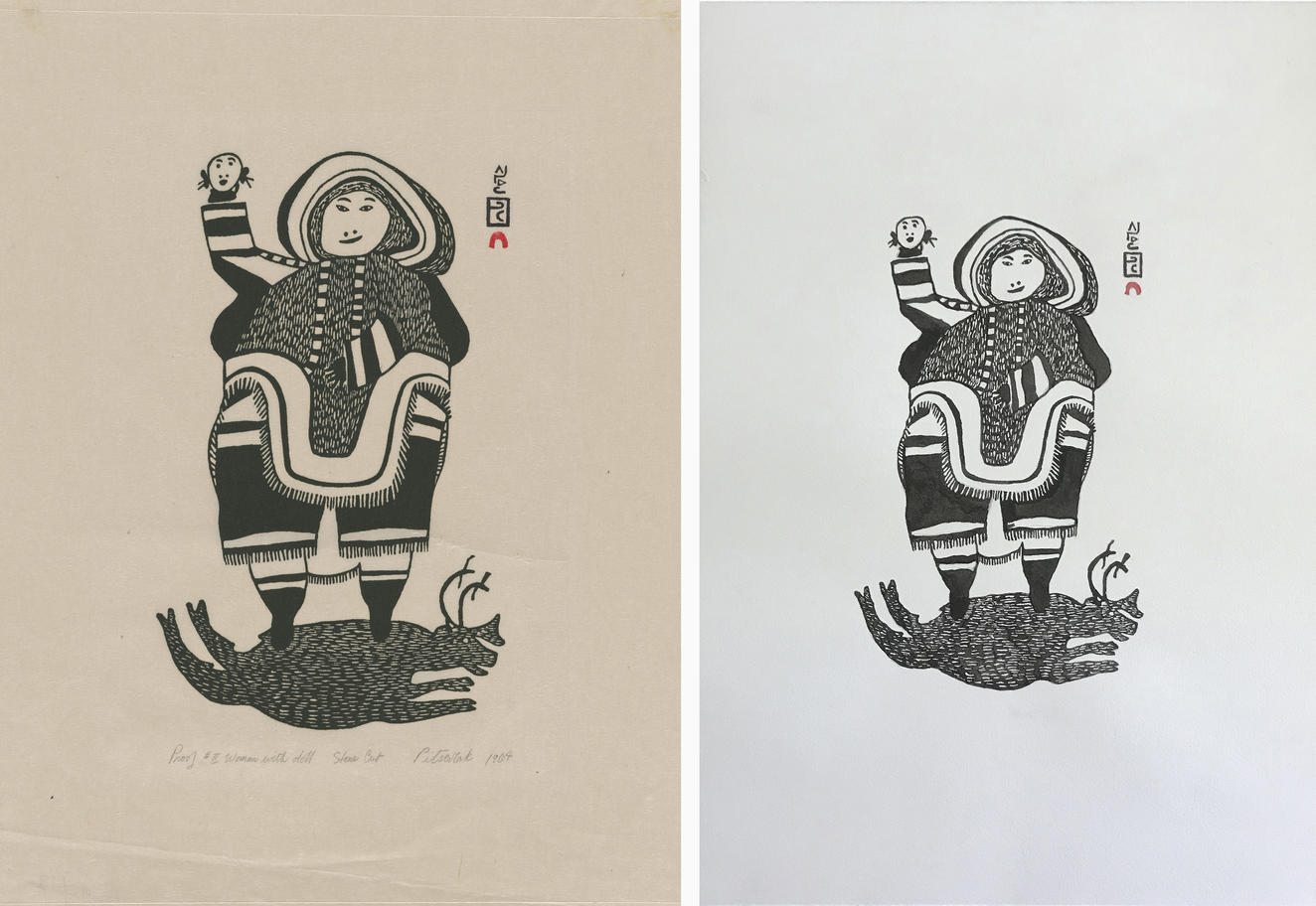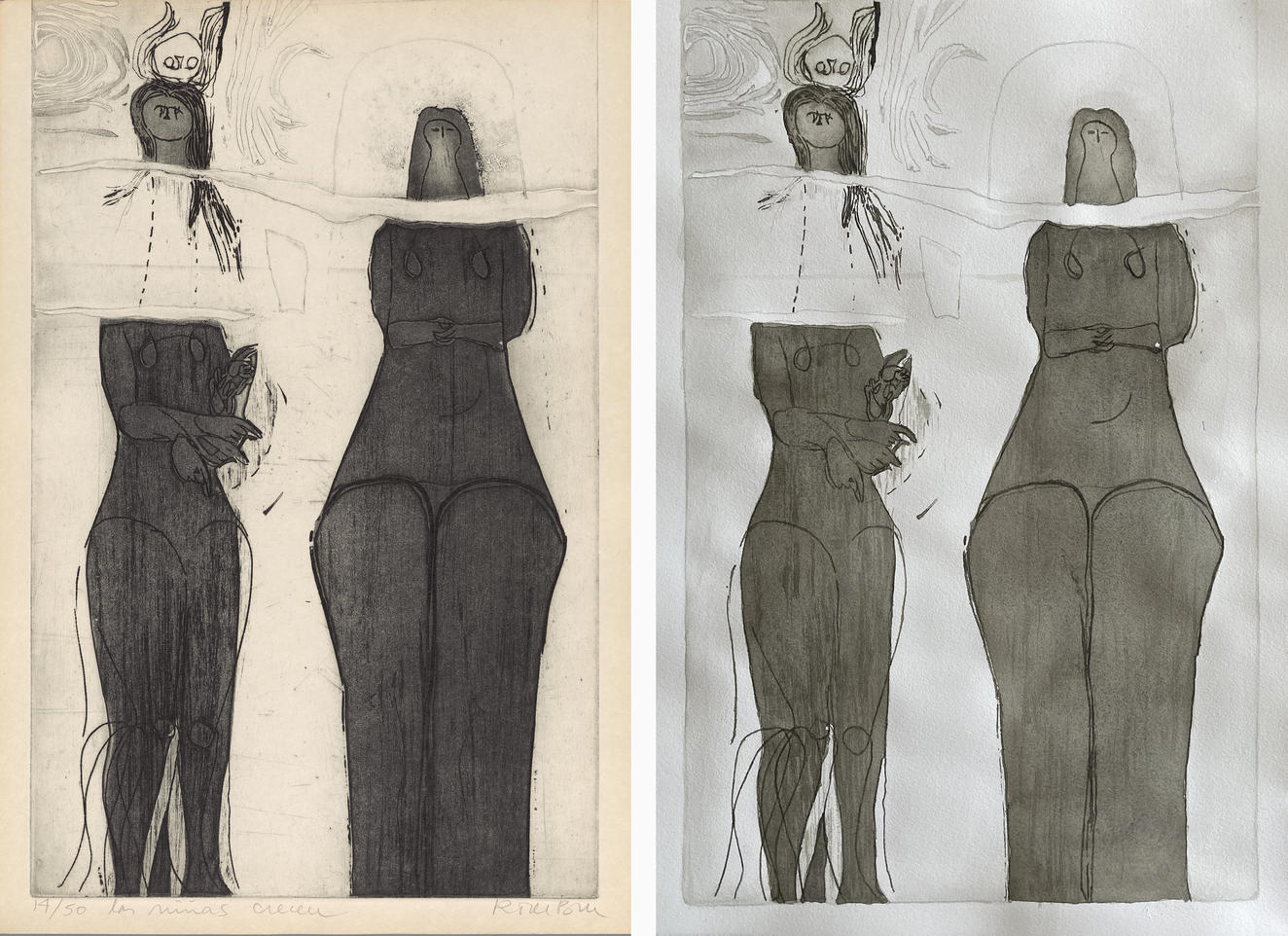When the pandemic hit, I found myself quarantined at my childhood home. The museum committed to sustaining work-study jobs, so I had the opportunity to develop a new remote project to replace my matting and framing work in the Conservation Department. At the time, I was making a copy of a detail from Nicole Eisenman’s painting Biergarten at Night and reflecting on the fragmented school year. I had made copies before, so the practice wasn’t foreign to me; however, for the first time, I found myself hesitate to call my drawing a “master copy.” All of the copies I made previously had been after conventional “masters” like Rembrandt, Goya, and Turner. I asked myself, “Can I call Nicole Eisenman a ‘master’?” I admire her as much as all those other artists, but unlike them, Nicole Eisenman is a contemporary female artist lacking the history of scholarship surrounding her that those other artists can claim. Therefore, can I call my drawing a “master copy”?
To answer this question, I needed to construct some sort of a definition of a “master copy.” First, we can understand copying as making a closely observed imitation of an art object. These copies are treated with the utmost respect and often stem from a desire to learn from an artist that someone admires. However, it is critical to acknowledge that, in Western art academies, this practice was, with very few exceptions, white men praising other white men. The word “master” further insinuates exclusivity. In order to call something a “master copy,” the artist being copied must belong to a predetermined group of artists of a certain class. Moreover, in Western culture, the word master possesses a dark history, and many definitions specify that a “master” is inherently a man. In this way, the idea of “master copies” greatly contradicts the necessary move away from the white male narrative that has dominated Western art history and education and museum structure. Similar exclusivity appeared when I reflected on my time working at the museum. Being away from the collection made me realize the amount of work housed in Prints, Drawings, and Photographs Department storage that is hidden behind the “A-list” works that are repeatedly pulled out for viewing.
During the latter part of the Spring 2020 semester, I made copies after three works on paper from the RISD Museum’s collection: Pitseolak Ashoona’s Woman with Doll, Roser Bru’s Las Niñas Crecen, and Akira Arita’s Untitled (Wooden Horse). With this project, I hope to showcase underrepresented artists and artworks that are overshadowed by “A-list” objects, move away from the concept of “master copies” and construct a practice of creating copies after artists that I admire, regardless of their conventional acclaim or classification as a “master.” In this way, I hope to break from the pervasive white, male, Western canon, which “master copies” serve to perpetuate. By maintaining the primary strength of the tradition of copying, and the respect and care connected to its execution, I hope to gain a deeper connection to these artists and their works.
Woman with Doll (1964), a stonecut on paper, was made early in Inuit artist Pitseolak Ashoona’s career. She is known for her portrayal of “the old Eskimo way of life,” her way of life for nearly forty years, focusing on the strengths of traditional camp society.1 Her work falls in line with Inuit Qaujimajatuqangit, an Inuktitut phrase that describes knowledge and values passed down through generations as “things we have always known, things crucial to our survival.”2 Pitseolak’s portrayals of Inuit culture are incredibly joyful. The people in her drawing and prints are nearly always smiling, and formally, she draws in a lighthearted, sentimental manner. In copying her print, this joy was evident in both the image itself and the mark-making involved in its construction. This print was created through a subtractive process, stonecutting, and I copied it using an additive process, drawing in ink. Being a printmaker, I could have copied Pitseolak’s work with a relief print of my own; however, the process of copying a print with a drawing intrigued me because it allowed me to view the medium in a new way. I constantly thought about the carving that went into the marks I was mimicking with ink—specifically the minute interactions between the tools and the matrix, or the stone printing surface. This vocabulary of the stonecut was incredibly difficult to translate into drawing, but through the process I discovered that even little, seemingly random carved marks in the figure’s clothing and shadow are organized in logical patterns.
Roser Bru was born in Barcelona, but, as a child, was exiled to Chile as a result of the Spanish Civil War.3 She was part of the Grupo de Estudiantes Plásticos, a group of artists who promoted informalism and abstraction in Chilean art.4 Among the aspects of her work that I find most intriguing, and relatable, are her contemporary readings of Goya’s prints and Frida Kahlo’s work and her many interpretations of Velazquez. It is somewhat ironic that I ended up making a copy after an artist who is herself very involved in copying. What initially drew me to the engraving Las Niñas Crecen was Bru’s use of bold lines and monumental figures, which are indicative of her work from 1960 through 1973.5 Surprisingly, my biggest takeaway from making this copy was a greater appreciation for plate tone. I was able to translate the figures and the engraved marks without much trouble, but the little scratches and subtle tonal shifts in the background, products of the printing process, were incredibly difficult to recreate. It is this plate tone that brings life to the negative space around these two imposing figures. By copying Bru’s print in an additive drawing medium I was again able to view a reductive printmaking medium with fresh eyes.
Akira Arita is a Japanese American artist who was born in Osaka, Japan, and attended and taught at RISD. I couldn’t find much information about him, but everything I was able to find seemed to focus on the surfaces he creates.6 I personally find his drawing Untitled (Wooden Horse) incredibly eerie. It is rendered beautifully and delicately, but the environment surrounding the toy horse is unsettling because it emphasizes an absence of life. This seemingly flat atmosphere is very deceiving and satisfying because the surface is a microcosm of texture created by small hatch marks. During my process of copying this work, creating the flat gray background took up most of my time. The labor that went into the seemingly simple atmosphere of the drawing is rather astounding and gives a certain conceptual weight to the sterile environment in which this object exists. Unlike my other copies, this one was executed in the same medium as the original.
It is time to break from the word master. There is no place for elitism and hierarchies in any contemporary art practice or institution. The first question I asked myself, “Can I call Nicole Eisenman a ‘master’?” perpetuates this history. There should be no hierarchical boundaries separating those artists who can be admired and studied from those who cannot. I was irresponsibly judging artists’ merit based on a scale established to bolster white men and sustain white male dominance in the arts. Redefining the practice of making copies and moving away from the white male Western canon and the notion of anyone as a “master” opens space for underrepresented artists and their wide range of artistic practices.
Caleb Getto is a senior at RISD in the Printmaking Department. Caleb has been a work-study student and the 2020 Fain Intern at the RISD Museum’s Conservation Department.
- 1Christine Lalonde, Pitseolak Ashoona: Life and Work website, “Biography,” https://aci-iac.ca/art-books/pitseolak-ashoona/biography.
- 2Christine Lalonde, Pitseolak Ashoona: Life and Work website, “Significance & Critical Issues,” https://aci-iac.ca/art-books/pitseolak-ashoona/significance-and-critical-issues.
- 3“Biography,” Roser Bru website, accessed May 15, 2020, https://roserbru.cl/biografia/.
- 4“Biography,” Roser Bru website, https://roserbru.cl/biografia/.
- 5Marcela Guerrero, Radical Women: Latin American Art, 1960–1985 digital archive, “Roser Bru,” Hammer Museum website, accessed May 18, 2020, https://hammer.ucla.edu/radical-women/artists/roser-bru.
- 6Michael Brenson, “Gallery View; 3 Japanese Artists in Search of a World Language,” New York Times, May 24, 1987.


